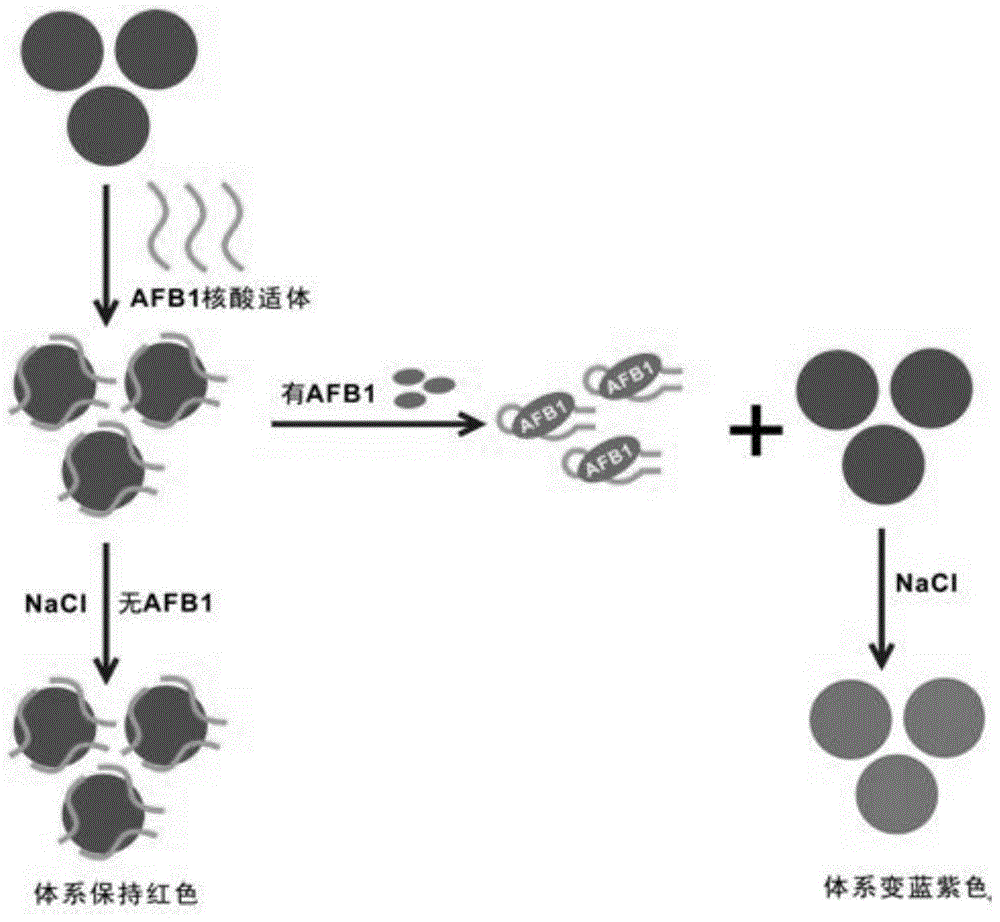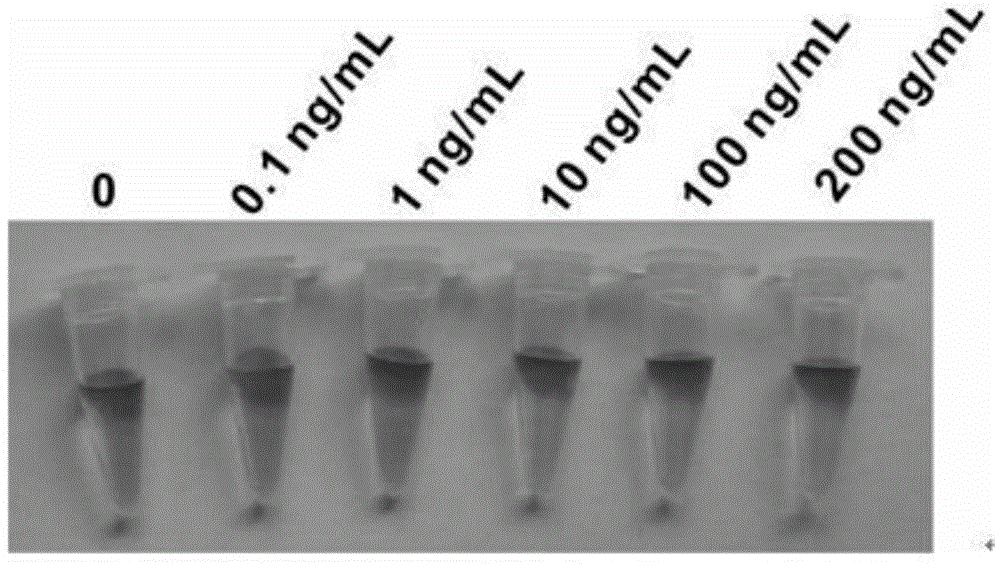Label-free visualization detection method and label-free visualization detection kit of aflatoxin B1
An aflatoxin and detection kit technology, which is applied in the direction of chemical reaction of materials and material analysis by observing the influence of chemical indicators, etc., can solve the problems of limited wide application, troublesome storage and high detection cost. , to achieve the effect of being suitable for widespread promotion, economical and low-cost
- Summary
- Abstract
- Description
- Claims
- Application Information
AI Technical Summary
Problems solved by technology
Method used
Image
Examples
Embodiment 1
[0028] A label-free visual detection kit for aflatoxin B1 comprises the following components:
[0029] (1) The nucleic acid aptamer of AFB1, the sequence is as follows:
[0030] 5'-GTTGGGCACGTGTTGTCTCTCTGTGTCTCGTGCCCTTCGCTAGGCCCACA-3' (SEQ ID NO. 1);
[0031] (2) Colloidal gold solution;
[0032] (3) 50 mM Tris-HCl solution (pH 7.4);
[0033] (4) 10 mM NaCl solution.
[0034] A label-free visual detection method for aflatoxin B1, comprising the steps of:
[0035] (1) AFB1 aptamer was dissolved in 50 mM Tris-HCl solution (pH 7.4) at a concentration of 20 nM;
[0036] (2) Add colloidal gold solution with a particle size of about 15 nM, mix well, and place at room temperature for 15 minutes;
[0037] (3) Add the sample to be tested, mix well, and react at room temperature for 30 minutes;
[0038] (4) Add 10 mM NaCl solution, mix well, react at room temperature for 10 minutes, observe the color change, the solution remains red, indicating that there is no aflatoxin B1 in the...
Embodiment 2
[0041] Detection of different concentrations of AFB1:
[0042] Prepare AFB1 standard solutions with concentrations of 0.1 ng / mL, 1 ng / mL, 10 ng / mL, 100 ng / mL, and 200 ng / mL, and store at 4 degrees.
[0043] AFB1 solutions of different concentrations were added to the reaction system described in Example 1, and the experimental results were observed after sufficient reaction, such as figure 2 As shown, 0.1 ng / mL of AFB1 can produce a clear blue color change, indicating that its detection limit is 0.1 ng / mL. As the concentration of AFB1 increased, the blue intensity increased and gradually became saturated.
Embodiment 3
[0045] Specificity experiment:
[0046] Prepare standard solutions of different interfering substances with a concentration of 100 ng / mL, namely aflatoxin M1, aflatoxin G1, ochratoxin A, zearalenone, patulin, citrinin and versicolor.
[0047] Add 100 ng / mL different interfering substance standard solutions and 1 ng / mL AFB1 standard solution to the reaction system described in Example 1 respectively, and observe the color change after sufficient reaction, as shown in image 3 As shown, 100 ng / mL of aflatoxin M1, aflatoxin G1, ochratoxin A, zearalenone, patulin, citrinin and versicolor remained red and had no effect on the detection. Only when AFB1 was added, the blue color change occurred, which proved that the method has good specificity for the detection of AFB1.
PUM
 Login to View More
Login to View More Abstract
Description
Claims
Application Information
 Login to View More
Login to View More - R&D
- Intellectual Property
- Life Sciences
- Materials
- Tech Scout
- Unparalleled Data Quality
- Higher Quality Content
- 60% Fewer Hallucinations
Browse by: Latest US Patents, China's latest patents, Technical Efficacy Thesaurus, Application Domain, Technology Topic, Popular Technical Reports.
© 2025 PatSnap. All rights reserved.Legal|Privacy policy|Modern Slavery Act Transparency Statement|Sitemap|About US| Contact US: help@patsnap.com



